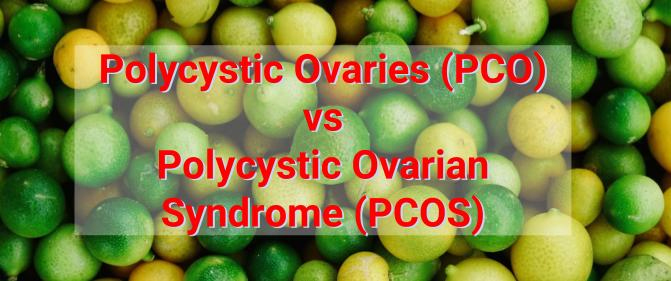Polycystic Ovaries vs Polycystic Ovarian Syndrome

What is the Difference?
A common confusion among women, is understanding the difference between having polycystic ovaries (PCO) and having been diagnosed with a Polycystic Ovarian Syndrome (PCOS).
PCO refers to an ultrasound scan image of the ovaries that appear to be polycystic (ovaries containing high density of partially mature follicles).
PCOS is a metabolic condition that may or may not come with having polycystic ovaries.
PCOS Without PCO
PCO is more common than PCOS and a patient maybe diagnosed with PCOS without PCO.
For example she may have PCOS with the following symptoms:
- Irregular periods
- Increased male hormone in the blood test or associated symptoms such as extra hair growth or acne.
Other conditions such as thyroid or pituitary dysfunction need to be excluded before PCOS diagnosis is made.
Similar Names But Different Risks & Treatments
The risks and medical treatments may be very different.
|
Issue |
PCOS |
PCO |
|
Who Does it Affect |
12-18% of women of reproductive age, (70% remain undiagnosed) |
Up to 33% of women of childbearing age having polycystic ovaries on ultrasound and no other symptoms. |
|
Type of Disorder |
A metabolic disorder associated with an unbalanced hormone levels released by the woman’s ovaries |
Not a disease but a variant of normal ovaries |
|
Effects |
Developing associated short and long-term effects |
Dissimilar profile |
|
Associated Risks |
Diabetes, pregnancy complications (ie. gestational diabetes), cardiovascular disease, obesity and endometrial cancer. |
Dissimilar profile |
|
Early Symptoms |
Evident early in life |
No symptoms and often discovered by chance |
|
Genetic Nature |
Can show symptoms (acne, excess hair growth etc.) in teen years, due to metabolic disturbance |
May show early but mostly discovered incidentally during health checks in older women |
|
Causes |
Linked to a hormonal disorder |
Cysts may be caused by a variety of reasons |
|
Hormonal Balance Disturbance |
Causing high insulin release stimulating production of androgens from the ovary disturbing ovulation. |
Undisturbed, with typically normal hormonal balance and continued regular ovulation |
|
Fertility |
Struggles with infertility and have problems falling pregnant |
Conception may not be difficult |
|
Miscarriage Rate |
Higher |
Normal |






